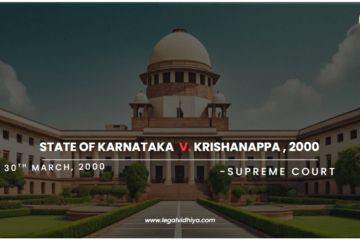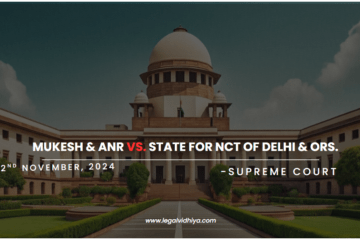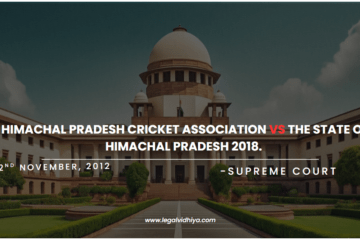
Case Overview:
| CASE NAME: | K.D. Kamath and Co. Vs. Commissioner of Income Tax, Mysore |
| Citation: | MANU/SC/0356/1971 |
| Coram: | C.A. Vaidialingam and P. Jaganmohan Reddy, JJ. |
| Date decided | 11.10.1971 |
| Civil Appeal No: | 1242 of 1968 |
| Counsel for appellant: | S.K. Venkataranga Iyengar and J. Ramamurthi, Advs |
| Counsel for respondent: | S.K. Iyer, and R.N. Sachthey Advs., |
| Acts Rules/statutes/orders: | Indian Contract Act, 1872 – Section 27; Indian Partnership Act, 1932 – Section 11, Indian Partnership Act, 1932 – Section 11(1), Indian Partnership Act, 1932 – Section 12, Indian Partnership Act, 1932 – Section 14, Indian Partnership Act, 1932 – Section 18, Indian Partnership Act, 1932 – Section 19(1), Indian Partnership Act, 1932 – Section 20, Indian Partnership Act, 1932 – Section 22, Indian Partnership Act, 1932 – Section 4, Indian Partnership Act, 1932 – Section 6 |
| Relevant Sections: | INDIAN INCOME-TAX ACT, 1922 – Section 26A |
| Prior History: | Appeal by special leave from the judgment and order dated January 21, 1964, of the Mysore High Court in I.T.R.C. No. 13 of 1963 |
| Disposition: | In Favour of Assessee |
| Cases overruled/partly overruled: | CIT Mysore v. K.D. Kamath & Co |
| Cases referred: | Balubhai Gulabdas Navlakhi vs. Commissioner of Income Tax, Bombay MANU/MH/0087/1961; Umarbhai Chandbhai vs. Commissioner of Income Tax, Bombay City MANU/MH/0017/1952; M.P. Davis vs. Commissioner of Agricultural Income Tax MANU/SC/0011/1958; Commissioner of Income Tax, Mysore vs. K.D. Kamat & Co. MANU/KA/0015/1964; Nani Gopal Biswas vs. The Municipality of Howrah MANU/SC/0052/1957; Commissioner of Income Tax, Gujarat vs. A. Abdul Rahim and Co. MANU/SC/0168/1964; Agarwal and Co. vs. Commissioner of Income Tax, Uttar Pradesh MANU/SC/0218/1970; Commissioner of Income Tax, Kerala vs. Pathrose Rice and Oil Mills, Irinjalkuda MANU/KE/0086/1959; P.A.C. Ratnaswamy Nadar & Sons Vs. Commissioner of Income Tax, Madras. MANU/TN/0508/1962; Commissioner of Income Tax U. P. Vs. R. S. Shoe Factory. MANU/UP/0214/1962; Murlidhar Kishangopal Vs. Commissioner of Income Tax, M. P., Nagpur and Bhandara. MANU/MP/0148/1962; City Tobacco Mart vs. Commissioner of Income Tax, Mysore |
Introduction:
A partnership is formed by a contract and is regulated by the Partnership Act of 1932. The partnership is also controlled by the basic provisions of the Indian Contract Act in areas where the Partnership Act is silent. It is specifically stated that any provision of the India Contract Act that is not abolished will be relevant to Partnership until and until such provision is in conflict with any provision of the Partnership Act, 1932. Contractual standards governing contract capacity, offer, acceptance, and so on will apply to the partnership as well. However, the regulations governing the minor’s status will be governed by the Partnership Act of 1932, as Section 30 of the Act addresses the position of the minor. It is a commercial organization formed by two or more people who have agreed to work collaboratively to carry out a business in order to benefit. It is an extension of a sole proprietorship. It is preferable to sole proprietorship since sole proprietorship is carried out by someone with limited capital and limited ability. Due to the limited resources of a single individual running a company on their own, a bigger company requiring more resources and investment than the sole proprietor has cannot be considered. In contrast, a partnership is formed when a number of partners pool their capital to form an agreement and carry out a company together.
Facts:
In this case, the appellant was a six-partner firm. The firm has been in operation since October 1, 1958, and the contract of partnership was signed on March 20, 1959. In addition, on August 11, 1959, the 1932 partnership was registered under the Indian Partnership Act. For the assessment year 1959-1960, corresponding to the preceding year ending March 31, 1959, the appellant firm submitted an application under section 26A of the Income Tax Act for registration of the partnership, to be done under the name of M/s. K. D. Kamath and Co. However, the Income-tax Officer, in a decree dated September 28, 1960, denied to approve the registration. The application was denied on the basis that the partnership deed dated March 20, 1959 was not authentic, and thus no partnership was formed.
The Income Tax Officer also indicated that K. D. Kamath was the only proprietor of the firm. Though the Income-tax Officer claimed that there is no legitimate partnership, the primary focus of his finding is that no relationship of partners was created under the aforementioned instrument. As a result, the appellant filed an appeal with the Appellate Assistant Commissioner (AAC), but he upheld the ITO’s decision. The appellant has filed an appeal with the Income-tax Appellate Tribunal. The Income Tax Appellate Tribunal determined that the two requirements of partnership put forth by the Courts for defining the partnership (i.e., an agreement between the partners to share profits and losses, and the partners acting as agents) were fully satisfied in this case. The Tribunal determined that the partnership agreement stated that the partners would share all profits and losses, and that the other partners might act as the firm’s agents (subject to K.D. Kamath’s authority). As a result, the partnership deed was deemed genuine, and the Income Tax Officer was directed to register the firm. The Commissioner of Income Tax then filed an application under Section 66(1) of the Income Tax Act, requesting that the Appellate Tribunal submit the matter of law raised in the application to the High Court. As a result, the Tribunal forwarded the case to the Supreme Court. The High Court ruled that because the parties agreed to share their earnings and losses, the first basic criterion for a partnership was met in this case. The High Court then focused on the second element, (i.e., whether the partners are functioning as agents or not). The high court remarked that because K.D. Kamath had entire control of the business, all of the other partners did not have the authority to act as agents of the other, hence the second fundamental element, (i.e.,) agency, was missing here. As a result, the High Court ruled that the company could not be registered. The appellant then filed an appeal with the Supreme Court against the High Court’s verdict.
Issues concerned:
- The first and most fundamental question in this case was whether all of the essentials of partnership established by the courts and the partnership act for assessing the legitimacy of a partnership were met.
- The major question in this case was whether M/s K. D. Kamath & Co. could be registered under Section 26A of the Income Tax Act for the assessment year 1959-1960.
Arguments of the parties:
| Arguments of the petitioner | Arguments of the respondents: |
| S. K. Venkataranga Iyengar, learned counsel for the appellant, alluded to various articles in the partnership agreement and argued that the High Court’s view that the necessary element of agency is absent in this case is incorrect. The attorney also contended that the partnership agreement provides no room for doubt. He contended with evidence that there is an agreement to share the business’s profits and losses in the proportion specified in the deed. As a result, one of the requirements for forming a partnership is met in this instance. The learned counsel also submitted that, while a greater amount of authority over the operation of the business might be entrusted in the hands of the K. D. Kamath (First Partner), circumstances do not preclude one partner from acting as agent for the other partners. Learned counsel pointed to several judgments of the High Courts and the Supreme Court that were relevant to this case. In that case, it was held that “the mere reality that more control is to be used only by one of the partners is not a situation which works against the parties having entered into a partnership contract as understood in law.” | Throughout the argument, Mr. S. K. Iyer, learned counsel for the revenue, endorsed the High Court’s rationale. Learned counsel argued that whether there is an agreement to share the profits and losses of the firm, and whether or not each of the partners has the authority to act as agent for all, must be determined by examining all of the circumstances as borne out by the partnership agreement. He emphasized the High Court’s conclusion (i.e., one of the basic elements, namely the right of one partner to serve as agent for all, did not exist in the current instance). Furthermore, the learned counsel contended that the High Court’s conclusion that the appellant is ineligible for registration under section 26A of the Income Tax Act is correct. Certain elements of the Partnership Act, as well as certain stipulations in the partnership agreement, were referred to by the experienced counsel. According to learned counsel, it is evident that the various authorities, as well as the High Court, have only evaluated parts of the partnership deed terms in reaching a decision one way or the other. |
Judgment:
The Supreme Court of India overturned the High Court’s verdict and ruling and granted the appeal. In this case, the court determined that all of the partnership’s basic conditions were met. As a result, the firm was deemed suitable for registration for the fiscal year 1959-1960.
Analysis:
Many important cases have highlighted the two important essentials for partnership (i.e., the presence of a partnership contract among the partners for the distribution of all profits and losses incurred in the firm’s business, and the partners acting as agents) in many important cases.
Similar to the second necessary, the Supreme Court of India declared that, according to Section 4 of the Indian Partnership Act, the firm’s business should be conducted by all partners or by any partner acting on behalf of the others. Even though the first partner, K. D. Kamath, has the authority and administration of the business in this case, all other parties from 2 to 6 are involved as working partners have to work under direction of K.D Kamath. As a result, it is apparent that K.D.Kamath conducts business on behalf of the other partners. As a result, the second criterion for the partnership is likewise met. This provision is supported by clause (16) of the partnership contract dated March 20, 1959. Clause (16) of the partnership deed states that “the firm’s affairs are to be carried on for mutual benefits,” and the deed also states that “the firm’s business was to be done for the common interests of all.”
Furthermore, Section 11 of the Partnership Act specifies that the parties can enter into agreements to define their rights and responsibilities. In this situation, there is also an agreement for profit and loss sharing. As a result, both prerequisites must be met. The partnership deed dated March 20, 1959 satisfies all of the requirements for a legitimate partnership. As a result, the firm was eligible for registration for the fiscal year 1959-1960. This particular case law is both intriguing and significant. By analysing this case law, one can gain a thorough understanding of the partnership.
***********
This article is written by S Abhipsha Dash, first year law student in Symbiosis Law School as an intern under legal vidhiya.
References:
1. MANU/SC/0356/1971
2. Indian Contract Act, 1872 – Section 27
3. Indian Partnership Act, 1932
4. MANU/MH/0087/1961
5. MANU/SC/0011/1958
6. MANU/KA/0015/1964
7. MANU/KE/0086/1959
8. MANU/SC/0218/1970
9. MANU/MP/0148/1962
10. MANU/TN/0508/1962




0 Comments